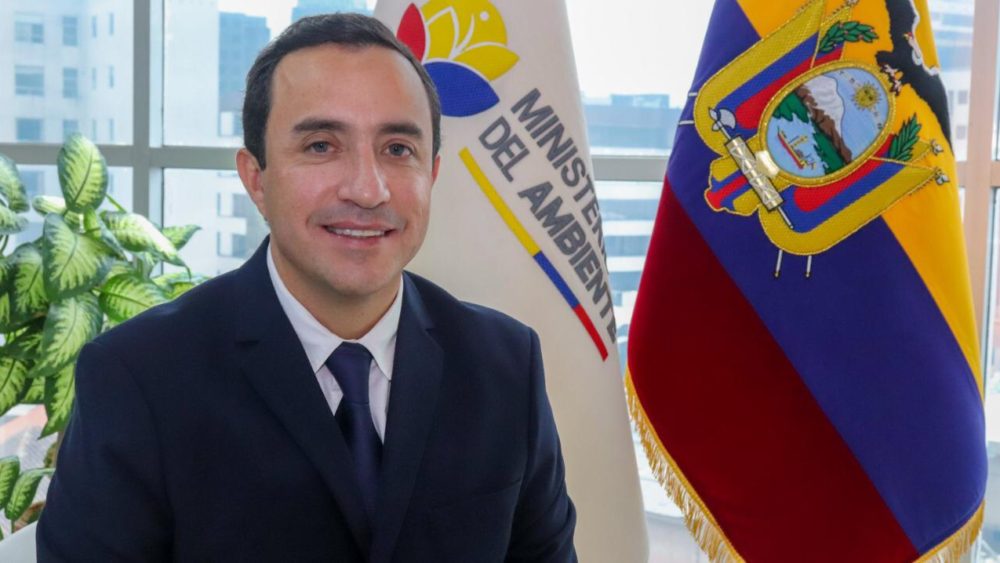On June 5, 1974, the United Nations (UN) established World Environment Day.
On this occasion, in the Third Edition of our Newsletter, we interviewed the Minister of Environment and Water, Paulo Proaño Andrade to learn about projects currently being lead by MAAE to protect the environment.
- What initiatives are being carried out regionally to help conserve the environment?
In order to guarantee the protection of the region’s natural resources, Ecuador signed the Leticia Agreement on September 6, 2019, in which the Governments of Colombia, Peru, Bolivia, Brazil, Suriname and Guyana agreed to take forceful measures to protect the Amazon that has more than half of the tropical forests of the planet and provides about 20% of fresh water on Earth.
This agreement seeks to strengthen coordinated action to fight deforestation; establish mechanisms for regional cooperation and information exchange; create the Amazonian Network for Cooperation in natural disasters and promote research, technological development, technology transfer and knowledge management processes.
In order to guarantee the conservation of our forests, the Ministry of Environment and Water promotes the Socio Bosque Project, whose objective is to conserve forests, mangroves and native moors nationwide by providing economic incentives to peasants and indigenous communities in exchange for their commitment to protect these ecosystems.
To date, 1,046 agreements have been signed involving an area of 1,356,492.57 hectares and an annual investment of $ 6,022,452.28 dollars that benefits 50,456 people in the six provinces of the Amazon region. This initiative has achieved a solid position internationally, as countries such as Peru, Bolivia and El Salvador are designing similar processes.
The Ministry has also signed an inter-institutional cooperation agreement with the Binational Development Plan of the Border Region – Ecuador chapter for the construction of the “Bosques de Paz” Administrative and Interpretation Center in Zapotillo canton, Loja province, on the Peruvian border.
These regional actions are based on compliance with international commitments such as the Ecuador-Colombia Binational Agreement and the Ecuador-Peru Binational Agreement, as well as international treaties such as: the Paris Agreement, the Convention on International Trade in Endangered Species of Flora and Fauna (CITES), the ITTO – OIMT Convention on International Trade in Tropical Timber, and the United Nations Forum on Forests – 2030 Forest Agenda.
- What role does the MAE play in protecting the environment nationally? What is its main mission?
In accordance with the provisions of the 2008 Political Constitution of the Republic of Ecuador, the Ministry of Environment and Water will ensure a healthy environment and respect for the rights of nature or pacha mama. It will guarantee a sustainable development model that is environmentally balanced and respectful of cultural diversity, which conserves biodiversity and the natural regeneration capacity of ecosystems, and ensures that the needs of present and future generations are met.
The main mission of this State agency is to exercise effective, efficient and transparent stewardship of environmental management and guarantee a harmonious relationship between the economic, social, and environmental axes that will ensure the sustainable management of strategic natural resources.
Through the application of public policies aimed at protecting national biodiversity Ecuador created the National System of Protected Areas, which currently conserves 18.4 million hectares in 59 protected areas, which represents 20.29% of the land area of the country and 12.07% of the national marine area.
Through forest restoration programs, it has also been possible to restore 90,374.01 hectares at the national level by planting native trees in degraded ecosystems throughout Ecuador.
- How can sustainability and conservation concepts be implemented in Ecuador?
Conservation and sustainability criteria go hand in hand and must be included when environmental projects are developed. Within this framework, the Comprehensive Amazon Program for Forest Conservation and Sustainable Production (PROAmazonía) is an opportunity for sustainable development through forest conservation and sustainable production.
The PROAmazonía project is executed under the leadership of the Ministries of Environment and Water and Agriculture and Livestock in order to implement actions that help reduce deforestation and forest degradation, and promote the sustainable management and conservation of natural resources to reduce greenhouse gas emissions associated with the forestry sector, and thus protect the environment.
Likewise, through the Program for Conservation and Sustainable Use of the Natural Heritage, our country seeks to increase the percentage of economic activities that use resources of biological origin as inputs for the provision of goods and services by 2021, which are goals of the National Bioeconomic Plan of Ecuador.
This objective views Bioeconomics as an opportunity for sustainable development through the use of natural resources to generate products with added value due to biodiversity and biotrade that will help diversify the productive matrix and combat poverty.
- How are natural resources and forests being protected in the Ecuadorian Amazon? How do these actions help protect the environment?
Through the Socio Bosque project, the National Forest Control System Project, the Amazon Without Fires Program, the National Forest Monitoring System, the National Reforestation Program, Proamazonía and the Early Movers Network Project (REM). These programs seek to protect, conserve and promote the sustainable management of biodiversity in Ecuador and improve the quality of life of people who live in or benefit directly from forests. In this way, they help to reduce greenhouse gases caused by deforestation and increase ecosystem services such as carbon storage and water regulation.
The Ministry of Environment and Water of Ecuador continually implements control measures nationwide with major emphasis on the Amazon to prevent actions such as illegal logging from displacing this vulnerable sector.
These preventive actions include the intensification of fixed and/or mobile controls, response to complaints, preliminary inspections of forest use programs and training provided to logging sectors and the general public.
 Español
Español English
English

Comments are closed.